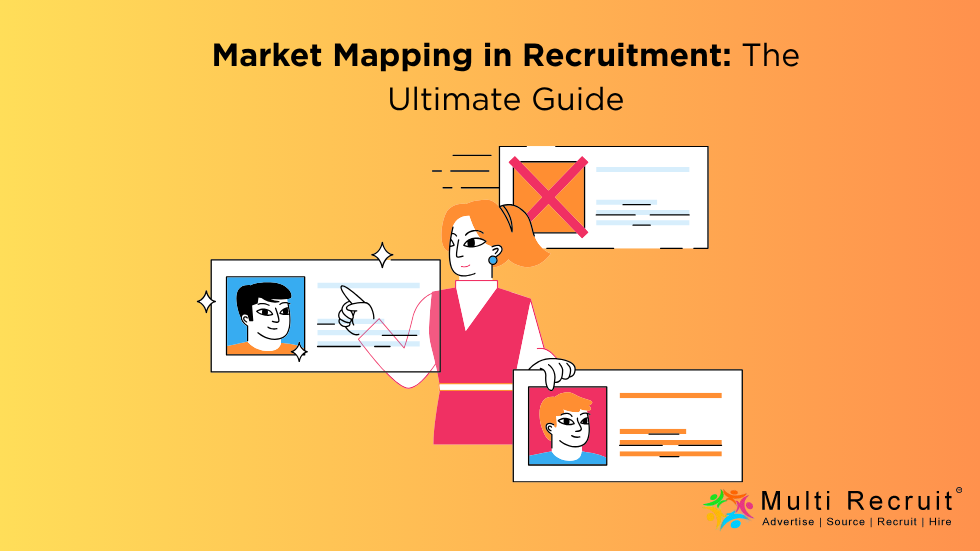In 2025, the recruitment environment is more dynamic than ever, with AI emerging into full-blown adoption, hybrid work models, and continued talent shortages. Market mapping is fast becoming a critical technique for talent acquisition—enabling businesses to identify and engage the best talent in competitive markets ahead of their competitors. This involves the ability to understand, visualize, and research the talent ecosystem across a certain role, industry, or location to give us a strategic competitive advantage in our hiring. Market Mapping is an HR and recruitment must.
If you’re in HR or Recruitment (and if you’re not you really should be), becoming a Ninja of market mapping could prove critical for closing skills gaps, increasing diversity, and cutting down time-to-hire. This definitive guide explains the basics, process, hurdles, and best practices of market mapping that can help you take your hiring strategy to the next level.
Why Market Mapping is So Important in 2025
Market mapping is more than just a tactical foray—it’s strategically essential to building robust workforce plans. With 70% of the world’s workforce projected to work remotely or in a hybrid model by 2025 and talent shortages impacting as many as 75% of all employers, traditional reactionary hiring doesn’t cut it. Market mapping enables companies to predict demand, benchmark competitors, and develop pools of talent, resulting in 40% faster hires and 20% savings. Neglect this and you will be looking at long-term vacancies (50-200% of someone’s salary in turnover).
AI and data analytics have increasingly revolutionized market mapping, making it more precise and scalable. But expectations around flexibility and DEI among candidates are changing, which complicates matters. A well-crafted market mapping program provides compliance, competitive intelligence, and long-term talent security; it helps companies navigate the unknown waters of economic prospects.
Key Steps in Market Mapping for Recruitment
The Right Market Mapping Process Good market mapping is done on a structured basis. Here are the basic instructions adapted for 2025:
- Establish Goals: Determine what you want to accomplish, like hiring for certain positions or targeting gaps in skills on your team or competitors. Map to business goals to stay targeted —After all, 65% of successful mappings begin by looking for where a company should align its efforts.
- Find Key Markets and Talent Pools: Target industries, geographies or workforce segments. Leverage tools such as LinkedIn or ATS to plot out where talent pools, including the passive candidates that constitute 80% of successful hires.
- Collect Data: Get candidate data, the structures of competitors, compensation and trends through databases and surveys and AI tools. Very good for accuracy if you have complete data, but can be time consuming.
- Analyze & Visualise: Produce maps or charts to visualise where the talent is, skill mismatches and opportunities. Tools such as Tableau or AI platforms showcase lacunae, and 70% of recruiters are leveraging visuals for greater insights.
- Engage and Pipeline Recruit:s Contact mapped talent with individual outreach. Monitor engagement to iterate strategies and building long term relationships for future hiring.
- Review and Update: Replenish maps often to reflect market changes and ensure timely appropriateness in a rapidly changing environment.
Comparative Analysis: Challenges Across Organization Sizes
| Challenge | Small Businesses | Large Enterprises | Solutions Focus |
|---|---|---|---|
| Data Collection Effort | High | Medium | AI Automation |
| Resource Constraints | High | Low | Outsourcing |
| Keeping Maps Updated | Medium | High | Real-Time Tools |
| Bias in Mapping | Medium | High | DEI Integration |
| Scalability Issues | High | Medium | Advanced Analytics |
Small businesses struggle with limited resources, while enterprises face complexities in global scaling and compliance.
Emerging Trends in Market Mapping for 2025
AI-driven mapping drives the trend – automating data capture and slashing manual efforts by up to 50%. Skills-first methods prevail, with 60% of organizations favoring competencies over qualifications to address mismatches. Hybrid models require virtual-mapping tools, while analytics focused on DEI keep pipelines inclusive. Predictive analytics predict the movement of people and allow advanced hiring in competitive markets.
Approaches to Addressing Market Map Obstacles
Use AI and Automation: Invest in AI solutions to collect and analyze data, which can save up to 40% of your time while decreasing the risk of mistakes.
- Embed DEI: Incorporate bias-detection software for diverse talent pools — 76% of candidates care about inclusivity.
- Work with Professionals: Pair outsourcing and close the lack of resource gaps for a more precise output.
- Regular Updates and Training: Plan quarterly reviews and up-skill teams to provide fresh maps.
- Candidate Focus: Provide a personal touch and increase response rates by 30% through tailored communication.
What Our Market Mapping Can Do For Your Business
Our machine learning power platforms streamline data collection and visualization, saving 35% in mapping time. Tailored tactics handle skill gaps and DEI, and real-time analytics supply the latest insights. We offer solutions that scale, and a proven ROI when companies allow us to demonstrate how we help businesses of any size create stronger talent pipelines.
Conclusion: Why Market Mapping?
In the competitive talent market of 2025, it will be essential to successfully map markets in order to address scarcities, bias, and hybrid challenges. Adopt a structured approach, embrace AI advances, and deploy the right strategies to help you attract A-list talent on your terms. We are committed to changing the way you hire with radical market mapping solutions in Multi Recruit. Choose Multi Recruit as your partner and gain a competitive edge to create the future today!

